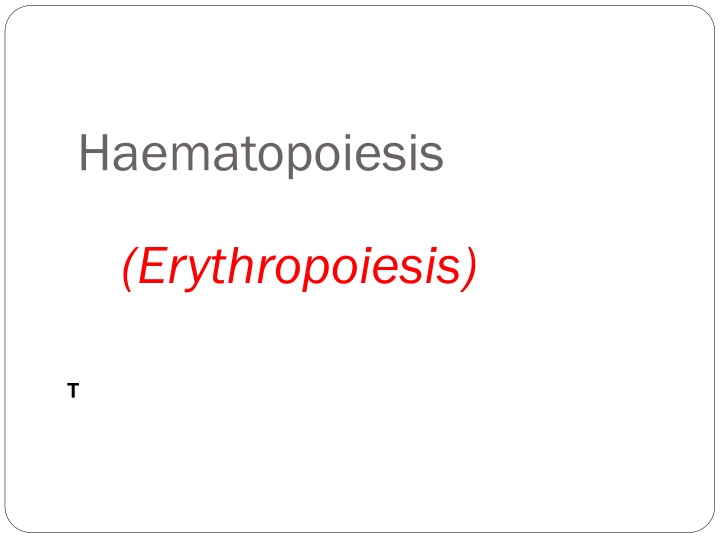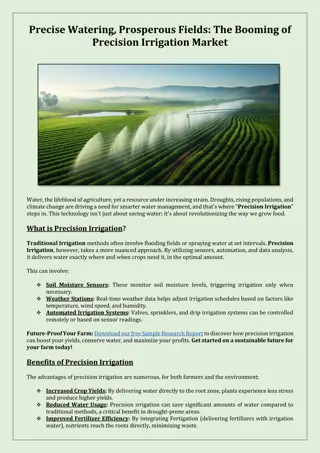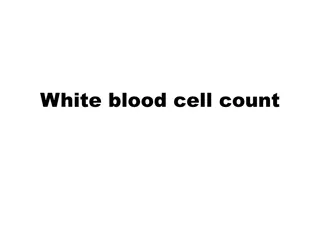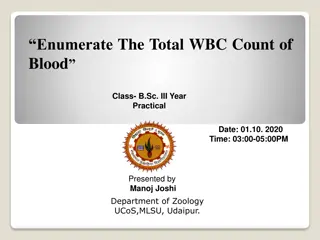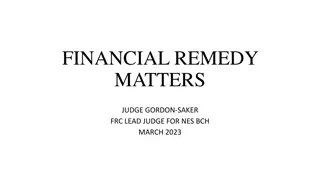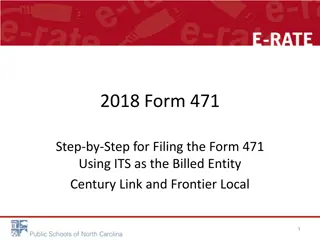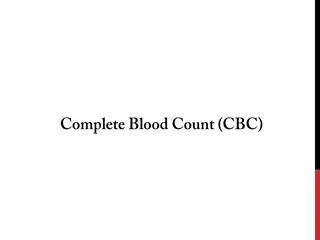Haematopoiesis
Discover the intricate process of blood cell formation known as haematopoiesis, focusing on erythropoiesis and the origin of different blood cell lineages. Explore the development stages from fetal to adult life, emphasizing the role of hematopoietic stem cells in generating vital blood components. Delve into the functions of leukocytes in the body's defense system and their diverse roles in maintaining health.
Download Presentation

Please find below an Image/Link to download the presentation.
The content on the website is provided AS IS for your information and personal use only. It may not be sold, licensed, or shared on other websites without obtaining consent from the author.If you encounter any issues during the download, it is possible that the publisher has removed the file from their server.
You are allowed to download the files provided on this website for personal or commercial use, subject to the condition that they are used lawfully. All files are the property of their respective owners.
The content on the website is provided AS IS for your information and personal use only. It may not be sold, licensed, or shared on other websites without obtaining consent from the author.
E N D
Presentation Transcript
Haematopoiesis (Erythropoiesis) T
Blood Cells derive from Hematopoietic Stem Cells Fetus - 0 2 months (yolk sac) - 2 7 months (liver, spleen) - 5 9 months (bone marrow) Infants - Bone marrow (practically all bones) Adults - Vertebrae, ribs, sternum, skull, sacrum and pelvis, proximal ends of femur
Haemopoietic stem cells haemopoietic stem cells (HSCs) are capable of both self-renewal and differentiation into the blood cell lineages (Multipotent). giving rise to two major lineages: 1. Lymphoid lineage : B and T cells (lymphocytes) 2. myeloid lineage : red cells, white cells, granulocytes and platelets
Blood Cell Origin and Production All new WBCs except for lymphocytes are produced in the bone marrow (that also give rise to erythrocytes and platelets). Most new lymphocytes are produced by colonies of cells in lymphoid tissues, such as lymph nodes Bone Marrow Circulation 6
Two major components of blood: liquid phase and formed elements 7
Leukocytes (WBCs) Mobile units of body s defense system: Seek and Destroy Functions: Destroy invading microorganisms Destroy abnormal cells (i.e., cancer ) Clean up cellular debris (phagocytosis) Assist in injury repair Each WBC has a specific function 10
Leukocytes (WBCs)(cont.) Five Types Classified according to the presence or absence of granules and the staining characteristics of their cytoplasm. Leukocytes appear brightly colored in stained preparations, they have a nuclei and are generally larger in size than RBC s. 12
Types of WBCs Are classified in 2 main classes Granulocytes A granulocytes 13
Types of WBCs (cont.) Granulocytes (Polymorphonuclear leukocytes): have 2 types of granules in their cytoplasm: The specific granules (specific functions) and azurophilic granules (lysosomes) Neutrophils Eosinophils Basophils 14
Types of WBCs (cont.) Agranulocytes: do not have specific granules, but they do contain azurophilic granules (lysosomes) in their cytoplasm Lymphocytes Monocytes 15
Granulocytes 1. Neutrophils Constitute 60-70% of circulating WBC s Have an average diameter of 12-15 m Several lobes in nucleus (2-5 segments) linked by fine threads chromatin Also contain glycogen (source of energy) Stain light purple with neutral dyes. 16
Granulocytes (cont.) 1. Neutrophils (cont.): Granules are small and numerous Highly mobile/very active Diapedesis: Can leave blood vessels and enter tissue space. Short lived cells: life span of 6-7h in blood and 1-4 days in connective tissues. Function: Phagocytosis (contain several lysosomes) and play a major role of acute inflammation. (release leukotrienes, prostaglandins, thromboxanes) 17
Granulocytes (cont.) 2. Eosinophils 2-4% in normal blood Large, numerous granules Typical bilobed nuclei Are about 12-17 m in size, pale blue colour Found in lining of respiratory and digestive tracts 18
Granulocytes (cont.) 2. Eosinophils (cont.) Persist in the circulation for 8 12 hours Functions: o Important functions involve protections against infections caused by parasitic worms and involvement in allergic reactions o Secrete anti-inflammatory substances in allergic reactions. 19
Granulocytes (cont.) 3. Basophils Least numerous, less than 1% of blood WBC s They are about 12-15 m diameter They contain many large, rounded, dark purplish black granules Their nucleus is divided into irregular lobes 20
Granulocytes (cont.) 3. Basophils (cont.) Diapedesis Contain histamine and heparin (inflammatory chemical) Function: Like eosinophils, basophils play a role in both parasitic infections and allergies 21
Agranulocytes 1. Lymphocytes Constitute 28% of WBC s Small lymphocytes (6-8 m); medium-sized lymphocytes (small number) and large lymphocytes (18 m) Large nuclei/small amount of cytoplasm Color pale-blue 22
Agranulocytes (cont.) 1. Lymphocytes (cont.) Only type of WBC s that return from the tissue back to blood after diapedesis Vary in life span: some live only a few days (~3days), others survive in circulating blood for many years (4-5 years) 23
Agranulocytes (cont.) 1. Lymphocytes (cont.) Function: immune responses and memory, mainly found in lymph tissue Two types: T lymphocytes attack an infect or cancerous cell B lymphocytes produce antibodies against specific antigens (foreign body) 24
Agranulocytes (cont.): 2. Monocytes Largest of WBCs (12-20 m) Dark kidney bean shaped nuclei Cytoplasm is basophilic and frequently contain very fine azurophilic granules In tissues differentiate into macrophages 25
Agranulocytes (cont.): 2. Monocytes (cont.) Function: phagocytosis Evident in chronic infections Tuberculosis Defense vs. viruses and certain bacteria Activate lymphocytes 26
WBC Numbers Doctors look at WBC numbers. Clinics will count the number of WBC s in a blood sample, this is called differential count A decrease in the number of white blood cells is leukopenia An increase in the number of white blood cells is leukocytosis 27
Variations in WBC Counts-Leukocytosis Physiological Causes of Leukocytosis Age Exercise After food intake Mental stress Pregnancy Exposure to low temperature also causes leukocytosis. Pathological Causes of Leukocytosis Acute bacterial infections especially by the pyogenic organisms Acute haemorrhage Burns 28
Variations in WBC Counts-Leukopenia Causes of Leukopenia Infections by the nonpyogenic bacteria, especially typhoid fever and paratyphoid fever Viral infections, such as influenza, smallpox and mumps Protozoal infections Starvation and malnutrition Aplasia of bone marrow Bone marrow depression due to: Drugs such as chloromycetin and cytotoxic drugs used in malignant diseases Repeated exposure to X-rays or radiations Chemical poisons like arsenic, dinitrophenol and antimony 29
Metabolismof leukocytes They have aerobic glycolysis and active pentose phosphate pathway (NADPH) During phagocytosis of bacteria, there is an increase of O2 consumption (respiratory burst: the rapid release of reactive oxygen species) and superoxide radical O2- (involved in killing the bacteria) is formed. 30
Metabolism of leukocytes (cont) Phagocytic leukocytes use NADPH as a substrate for the NADPH-oxidase enzyme, which contributes to the killing of ingested microorganisms NADPH NADPH +A +O2 NADP+ + AH + O2- oxidase Acidic pH 2H+ + 2O2 - 2H2O2 + AH + O2- SOD Helps to kill microorganisms 31
Metabolism of leukocytes (cont) Active leukocytes release O2- ions and H2O2 to surrounding tissues in areas of inflammations Superoxide dismutase, catalase and glutathione peroxidase are normal antioxidant enzymes that help to protect the body against the toxic effect of O2- ions and H2O2 32
Structure and Composition of Platelets Also known as thrombocytes (thrombo = clot ; cytes = cells). Platelets are the smallest blood cells varying in diameter from 2 to 4 m with an average volume of 5.8 m3. 34
Structure and Composition of Platelets (cont.) Platelets are colourless, spherical, or oval discoid structures. Leishman staining shows a platelet consisting of faint bluish cytoplasm containing reddish purple granules. Nucleus is absent in the platelets and therefore these cannot be reproduced. 35
Electron Microscopic Structure Cell Membrane- It consists of lipids (phospholipids, cholesterol and glycolipids), carbohydrates, proteins and glycoproteins. 36
Electron Microscopic Structure Microtubules- The microtubules are made up of polymerized proteins called tubulins. These form a compact bundle, which is present immediately beneath the platelet membrane. These are responsible for maintenance of the discoid shape of the circulating platelets. 37
Electron Microscopic Structure (cont.) Cytoplasm -The cytoplasm of the platelets contains the following: Endoplasmic reticulum and Golgi apparatus (synthesize various enzymes and store large quantities of calcium). Mitochondria are capable of forming ATP and ADP. Contractile proteins include actin, myosin and thrombosthenin (can cause the platelet to contract and are thus responsible for the clot retraction). 38
Electron Microscopic Structure (cont.) Other proteins present in the cytoplasm are as follows: Fibrin stabilizing factor Platelet-derived growth factor (PDGF) von Willebrand factor (VWF) 39
Electron Microscopic Structure (cont.) Granules present in the cytoplasm of platelets contain: Substances like phospholipids Triglycerides cholesterol ATP ADP serotonin (5HT). Enzymes present in the cytoplasm of platelets include: Adenosine triphosphatase Enzymes necessary for the synthesis of prostaglandins 40
Properties of Platelets Adhesiveness: Platelets possess the property of adhesiveness, i.e. when they come in contact with any wet surface or rough surface, they get activated and stick to the surface. Factors responsible for adhesiveness are collagen, thrombin, ADP, thromboxane A2, calcium ions and VWF. Aggregation: Platelets have the property to aggregate, i.e. they stick to each other. This is due to ADP and thromboxane A2. Agglutination: Clumping together of platelets is called agglutination. This occurs due to the actions of some platelet agglutinins. 1. 2. 3. 41
Functions of Platelets When activated, platelets perform the following functions: Role in Haemostasis Haemostasis refers to the spontaneous arrest of bleeding from an injured blood vessel. Role in Clot Formation Platelets play an important role in the formation of the intrinsic prothrombine activator, which is responsible for the onset of blood clotting. 43
Functions of Platelets Role in Clot Retraction Contraction of contractile proteins (actin, myosin and thrombosthenin) present in the platelets plays an important role in clot retraction. Role in Repair of Injured Blood Vessels. Role in Defense Mechanism Platelets Due to their property of agglutination, are capable of phagocytosis. Transport and Storage Function The 5HT is stored in the platelets and transported to the site of injury where it is released. 44
Functions of Platelets (cont.) Normal platelet count ranges from 150,000 to 450,000 / mm3, with an average count of 2.5x105 / mm3 Thrombocytosis: An increase in the number of platelets more than 4.5 x105 / mm3 Thrombocytopenia: A decrease in the number of platelets below 1.5 x105 / mm3 Lifespan of platelets varies from 8-10 days with an average of 10 days. Destroyed by the tissue macrophage system in the spleen. 45
